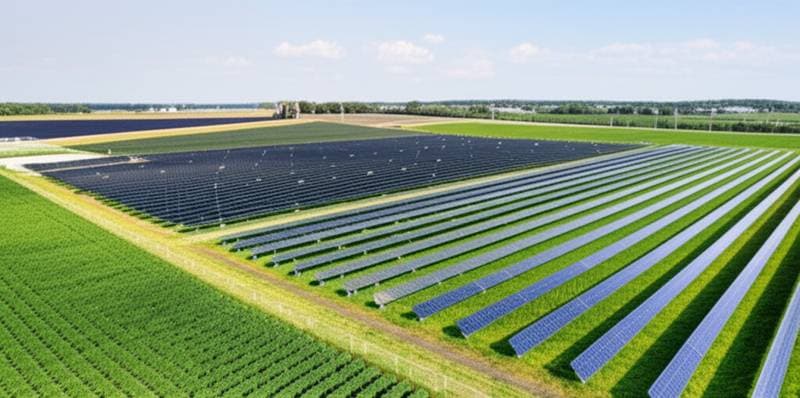Understanding the Rise of Agrivoltaics in 2025
Rural landscapes across counties undergo a subtle shift as solar panels emerge above growing crops. This innovative method, known as agrivoltaics, merges agricultural practices with solar energy production on the same terrain. The approach enables simultaneous cultivation of food and generation of renewable power, eliminating the need to prioritize one over the other.
Farmers confront volatile weather patterns and narrow profit margins. Agrivoltaics provides a viable solution by diversifying revenue sources. Solar developers gain entry to valuable land resources previously off-limits. This dual-purpose strategy reshapes perspectives on renewable energy integration and long-term food supply stability.
Prioritizing Safety in Structural and Electrical Design
Safety forms the foundation of any agrivoltaic installation on agricultural land. Elevated solar arrays introduce electrical infrastructure, mounting supports, and cabling that demand precise engineering to mitigate hazards.
Homeowners and farmers must engage licensed electricians for all wiring tasks involving panels, inverters, and buried conduits. Faulty grounding or insecure connections invite electrical shocks, ignition sources, or system malfunctions.
Essential elements of a secure agrivoltaic configuration include:
- Ground-fault circuit interrupters and arc-fault detection systems that adhere to National Electrical Code standards
- Comprehensive bonding and grounding for metallic components
- Durable, weather-resistant junction boxes and conduit connections
- Designated pathways for emergency responders and routine upkeep
Proximity to livestock enclosures, irrigation networks, or conductive fencing necessitates additional isolation protocols. Installers qualified in agricultural settings confirm that all materials suit outdoor, farm-based applications.
Operational Mechanics of Agrivoltaic Systems
Agrivoltaic setups position solar panels at heights of several feet above ground level, permitting adequate sunlight penetration to crops below. Strategic spacing generates patterns of illumination and shadow, which moderate soil temperatures, curb moisture loss, and shield vegetation from excessive heat.
Irrigation pipelines frequently route beneath the arrays, with precision drip methods minimizing water usage. Support structures occasionally serve as frameworks for vining plants. Operators adjust panel angles seasonally to optimize both photosynthetic needs and electricity output.
Selecting Suitable Crops
Partial shading limits crop viability to shade-tolerant varieties that withstand fluctuating light and thermal conditions. Optimal selections encompass:
- Leafy vegetables including lettuce, spinach, and kale
- Underground produce such as carrots and beets
- Pasture grasses for animal feed
- Aromatic plants like basil and mint
Site-specific evaluations assess subsurface hydration and photon distribution beneath panels. Regional agricultural extension services assist in establishing experimental areas prior to comprehensive deployment.
Financial Advantages and Broader Societal Impacts
Well-executed dual-use installations yield consistent earnings from land that could otherwise lie idle. Landowners lease portions to solar firms while sustaining crop cultivation or pastoral activities.
Research from the National Renewable Energy Laboratory indicates that agrivoltaic arrangements elevate overall land efficiency per acre beyond traditional monoculture fields or standalone solar facilities. Blended income from power sales and harvests fosters economic durability, particularly in drought-vulnerable or price-fluctuating areas.
Societal gains surpass farm boundaries. Such initiatives:
- Bolster regional food systems alongside expanded clean energy infrastructure
- Minimize topsoil degradation through persistent vegetative coverage
- Generate employment in technical and farming sectors
- Invigorate countryside economies via utility contracts
Pennsylvania authorities increasingly promote dual-use solar through targeted rebates, harmonizing agricultural conservation with energy expansion.
Accommodating Livestock and Equipment in Layouts
Numerous operations incorporate herd grazing beneath solar canopies. Sheep prevail as the preferred species, managing undergrowth without compromising hardware. Larger animals like cattle or goats demand sturdier frames and barriers.
Designers ensure equipment pathways accommodate tractor widths and maneuverability. Array alignments provide sufficient gaps for operational clearance. Subsurface cabling buries at depths resistant to plowing, marked with alerts for buried utilities.
These specifications affect yield outcomes and power system dependability. Electrical specialists versed in farm contexts validate wire gauges, voltage reductions, and protective current routes prior to activation.
Ecological and Climatic Advantages
Agrivoltaic deployments cut greenhouse gas outputs by displacing coal and gas-based electricity. They safeguard arable areas by preventing wholesale transformation into solar-only zones. Panel-induced shade fosters beneficial microhabitats for insects and microbes, nurturing robust biodiversity.
Moisture conservation ranks high among benefits. Covered earth holds water extended periods, potentially slashing irrigation demands by 25 percent in arid locales. This efficiency proves crucial where resources strain or pumping expenses escalate.
Overcoming Implementation Hurdles
Interest in dual-use solar surges, yet obstacles persist. Upfront investments loom large, and remote sites may lack robust grid connections for added capacity. Upkeep complexities arise from divergent timelines for panel cleaning and field tending.
Operators track ground compression from construction traffic and manage drainage from array surfaces. Certified technicians conduct periodic electrical audits to verify bonding efficacy and dielectric strength.
Regulatory processes differ by locale. Certain districts treat projects as farm enhancements, while others deem them utility-scale. Consult governing bodies early in planning phases.
Practical Actions for Prospective Implementers
Prospective agrivoltaic adopters initiate with thorough site analyses. Gauge irradiance levels, soil profiles, intended harvests, and utility service availability. Partner with accredited installers proficient in rural deployments. Secure electrical clearances and align with providers on grid ties.
Ongoing management involves clearing foliage near apparatus, scrutinizing cabling for wear, and logging performance metrics. Promptly summon qualified electricians for diminished yields or recurrent interruptions. Refrain from accessing live circuits or performing unguided fixes.
Pennsylvania resources, including energy bureaus and extension networks, link participants to funding opportunities and expertise. As agrivoltaics matures, its capacity to harmonize productivity and sustainability becomes evident.
